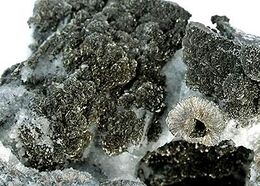Chemistry:Rammelsbergite
From HandWiki
| Rammelsbergite | |
|---|---|
 | |
| General | |
| Category | Mineral |
| Formula (repeating unit) | NiAs2 |
| Strunz classification | 2.EB.15a |
| Crystal system | Orthorhombic |
| Crystal class | Dipyramidal (mmm) H-M symbol: (2/m 2/m 2/m) |
| Space group | Pnnm |
| Unit cell | a = 4.759 Å, b = 5.797 Å c = 3.539 Å; Z = 2 |
| Identification | |
| Color | Tin white with a faint pinkish hue |
| Crystal habit | Rarely as prismatic crystals; commonly massive, granular, radial, fibrous |
| Twinning | On {101} |
| Cleavage | Distinct on {101} |
| Fracture | Irregular |
| Tenacity | Brittle |
| Mohs scale hardness | 5.5–6 |
| |re|er}} | Metallic |
| Streak | Grayish black |
| Diaphaneity | Opaque |
| Specific gravity | 7.0–7.1 |
| Optical properties | Strongly anisotropic |
| Pleochroism | Weak, yellow to pinkish hue and bluish white |
| References | [1][2][3] |
Rammelsbergite is a nickel arsenide mineral with formula NiAs2. It forms metallic silvery to tin white to reddish orthorhombic prismatic crystals, and is usually massive in form. It has a Mohs hardness of 5.5 and a specific gravity of 7.1.
It was first described in 1854 from its type locality in the Schneeberg District in Saxony, Germany . It was named after the Germany chemist and mineralogist, Karl Friedrich August Rammelsberg (1813–1899).[2]
It occurs as a hydrothermal mineral in medium temperature veins association with skutterudite, safflorite, lollingite, nickeline, native bismuth, native silver, algodonite, domeykite and uraninite.[1]
See also
References
- ↑ 1.0 1.1 Handbook of Mineralogy
- ↑ 2.0 2.1 Mindat.org
- ↑ Webmineral data
- ↑ Warr, L.N. (2021). "IMA–CNMNC approved mineral symbols". Mineralogical Magazine 85 (3): 291–320. doi:10.1180/mgm.2021.43. Bibcode: 2021MinM...85..291W. https://www.cambridge.org/core/journals/mineralogical-magazine/article/imacnmnc-approved-mineral-symbols/62311F45ED37831D78603C6E6B25EE0A.
- Mineral Galleries
- Schumann, Walter (1991). Mineralien aus aller Welt. BLV Bestimmungsbuch (2 ed.). pp. 223. ISBN 978-3-405-14003-8.
 |

